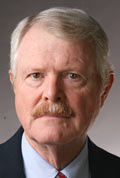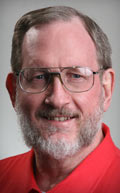Murphy, Sweeney's long careers honored at retirement reception

Michael Murphy

Donald Sweeney
Two retiring educators at Texas A&M’s College of Architecture who helped mold generations of landscape architects and urban planners while amassing more than 80 years of combined service were honored at a May 15, 2011 reception in the college’s Wright Gallery.
As a room packed with well-wishers looked on, Michael Murphy and Donald Sweeney were lauded by colleagues during a program led by Forster Ndubisi, head of the Department of Landscape Architecture and Urban Planning.
Since 1969, Murphy, a professor of landscape architecture, has taught interdisciplinary design and programming, environmental planning and design and landscape architecture theory at Texas A&M.
He also directed numerous projects in the department’s Partnership for Community Outreach program, in which students take on landscape architecture and planning projects for Texas communities.
Recent outreach efforts included a planning and revitalization project of a historic district in Castroville, Texas, a growing community 25 miles west of San Antonio.
Among Murphy’s many leadership roles at the college were a 1989-91 term as head of the Department of Landscape Architecture and a 2001-02 post as the coordinator of the Bachelor of Landscape Architecture program.
Murphy has written or co-authored numerous books and articles including "Landscape Architecture Theory," Waveland Press, 2005; "The Changing Nature of Landscape Architectural Practice: the South African Experience," Journal of Architecture and Planning Research, 2002; "The Emerging Nature of Landscape Architecture in South Africa," International Federation of Landscape Architects 2001 Yearbook; “Landscape Architecture 2000: Curriculum Guide for Landscape Architecture Education in South Africa,” Department of Architecture and Landscape Architecture, University of Pretoria, Republic of South Africa, 1999.
He came to Texas A&M after earning a Master of Architecture degree from the University of California-Berkeley in 1968; before that, he earned two bachelor’s degrees from Texas A&M: a Bachelor of Landscape Architecture degree in 1966 and a Bachelor of Science in Range Science in 1961. In 1999, he earned a Ph.D. from the University of Pretoria.
Sweeney, the first coordinator of the college’s Bachelor of Science in Urban & Regional Science program, which began in the fall 2007 semester, is an associate professor in health systems planning in the Department of Landscape Architecture and Urban Planning and an associate professor in the School of Rural Public Health in the Texas A&M University System Health Science Center.
He had many leadership roles in the college during his tenure, including a 1985-87 stint as interim dean and a 1985-88 post as head of the former Department of Urban and Regional Planning.
His professional and research interests include all aspects of health systems policy, planning and management. He has consulted with communities, public agencies, major corporations and health/human service organizations addressing issues such as organizational learning, transformational leadership, corporate transformation, visioning and strategic planning.
He was the first chairman of Healthy Texas Communities, a statewide forum for individuals, organizations, agencies and communities interested in building healthier places to live.
Among his numerous published papers are “Long-Range Plan: Children’s Heart Institute of South Texas,” Texas A&M University, 1984; “The Needs of the Economically Distressed: Brazos Valley Region of Texas,” Texas A&M University, 1984; “Systems Building and Campus Facilities,” Journal of Higher Education, 1972; “Systems Buildings Lowers Cost, Coordinates Planning,” Journal of the American Hospital Association, 1972; “Rural Health Delivery System: Texas 7-C Medicare Hospitals,” Texas Hospitals, 1973.
Sweeney joined the faculty in 1972 after earning all his degrees from Texas A&M: a Doctor of Environmental Design in 1972, a Master of Architecture in 1968 and a Bachelor of Arts in English in 1967.
Tags
Related Posts
College names six outstanding alumni

College names eight Outstanding Alumni
Nine companies on Aggie 100 list led by arch. college grads

Nominations for outstanding college alumni due March 1
Follow Us
Facebook Twitter Vimeo Youtube Flickr RSS
Recent Posts

Planning prof heads study of disaster housing aid

A message from the dean

Former student remembered as expert planner

Leading educator named new head of Architecture Dept.















_thumbnail_small.png)
